This is a Foth Derby folding strut camera made in Germany by C.F. Foth & Co. The Foth Derby was in production from 1930 to about 1940 and was designed as a lower cost alternative to Leica and Contax cameras of the time. It was a direct competitor to the Kodak Vest Pocket camera and used that camera’s 127 format film. Originally designed to make sixteen images of 24 mm x 36 mm like the Leica, in 1931 was redesigned to take advantage of the larger 127 format film and would make sixteen 30 mm x 40 mm images. Although sold as a lower cost camera, it was still built well and came with a variety of quality lenses, had a focal plane shutter with a fast 1/500 top speed, a self timer, and in later years, could be had with a built-in rangefinder.
Film Type: 127 Roll Film (sixteen 4cm x 3cm exposures per roll)
Lens: 5cm f/2.5 Foth Anastigmat uncoated 4-elements
Focus: 2.5 feet to Infinity
Viewfinder: Flip up Scale Focus Viewfinder
Shutter: Cloth Focal Plane
Speeds: B, 1/25 – 1/500 seconds
Exposure Meter: None
Battery: None
Flash Mount: None
Manual: http://www.cameramanuals.org/pdf_files/foth-derby.pdf
History
C.F. Foth & Co was founded in Berlin, Germany in 1926 by a Dutch mechanic named Carl Friedrich Foth. Not much is known about Carl Foth, other than he was likely born in the late 1800s somewhere in the Netherlands. At some point in his youth, he relocated to the Baltic city of Gdańsk which depending on when he arrived, was either part of the German Empire (pre-1919) or independent Poland.
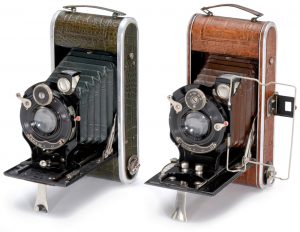
The earliest information I could find about Carl Foth was that in 1924, he opened his own workshop in Gdańsk, Poland where he produced his first products. He made binoculars, microscopes, radios, and headphones, but very few of his earliest products are known to survive. Foth would not stay at this first workshop long, as he would relocate to Berlin by 1926 to start C.F. Foth & Co. The company would not produce it’s first photographic camera until around 1929 at which time they starting making a small variety of folding plate and roll film cameras. Many of their early cameras were 6.5 cm x 9 cm folding plate cameras, but they also made a few different 6 cm x 9 cm and 6.5 cm x 11 cm roll film models, and at least one TLR called the Foth Flex. The cameras were rarely given any kind of unique names like the “Derby” and were generally known as Foth Special, Foth Film 6×9, and Foth Film 6.5×11.
It is puzzling to me that Foth seemed to come and go without much fanfare, as their cameras seemed to be pretty well designed. Although a rather basic camera, the Foth Derby was built to typical high German standards. Introduced in 1930, the Foth Derby was in production for at least a decade. The camera featured a well built focal plane shutter with a top speed of 1/500 seconds, a self timer, a body mounted shutter release, and it came equipped with either a 4-element f/2.5 Foth Anastigmat lens, or a 3-element f/3.5 lens.
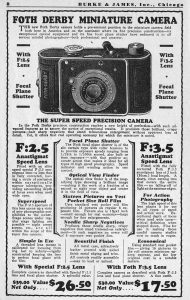
When introduced, the Derby was positioned as the discount German competitor to the Leica and Contax. In 1933, the Foth Derby sold in the United States for $17.50 with the f/3.5 lens, and $26.50 with the f/2.5. When adjusted for inflation, that’s $332 and $502 today. Certainly not cheap, but it’s about 1/5th the cost of the aforementioned Leica and Contax models.
The Foth Derby continually evolved during its 10+ year run. The original model lacked the self-timer, and although it used 127 format film, it had a film gate size of 24mm x 36mm which was identical to 35mm film. A year after it’s release, the Foth received a self-timer and the film gate size increased to 30mm x 40mm to take advantage of the full size of 127 film.
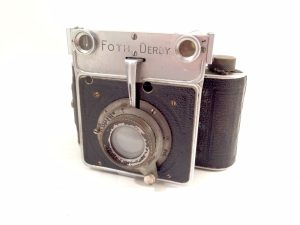
In 1936, a modified Foth Derby known as the ‘Model II’ was sold in the United States by Burleigh Brooks, which featured a coupled rangefinder mounted to the top plate of the camera. The rangefinder added quite a bit of heft to the Derby, and based on how rare it is today, I doubt many were sold.
Unlike other low-end camera makers who would outsource the shutter or lens design to someone else, Foth cameras seem to all have Foth branded lenses and Foth designed shutters. There were no Compur shutters, or Schneider lenses on any Foth cameras I’ve seen. The image above of two Foth 6×9 folders look to be pretty nice looking, covered in an alligator skin leather.
Foth’s most successful model was definitely the Derby, as it was in production for nearly a decade and although I couldn’t find any type of production numbers, they show up quite often on eBay, so that suggests that quite a few were sold. The Derby was unusually popular in Japan as well, being sold by Japanese importers all throughout the 1930s and 40s. There are still quite a number of Japanese language fan sites for the Foth Derby.
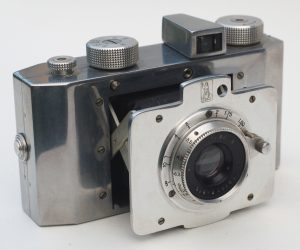
Production of the Derby would cease in early 1940 around the same time that the entire Foth company went bankrupt. Starting in 1939, the Nazi regime in Germany transitioned to something called Kriegswirtschaft (in English, war economy) in which German industry would begin to produce products for the war effort. Many German optics companies would make optics products for the German military, but for unknown reasons, Foth didn’t, and that was the end of the company. Not much else is known about why Foth didn’t continue past 1940, perhaps they were unsuccessful at transitioning to the demands of the German military, or perhaps the company simply didn’t want to participate.
After the war, the design of the Derby was either bought out, or perhaps taken as war reparations by a French company called Gallus who in 1945 would re-release the camera as the Gallus Derby-Lux. The Derby-Lux came with different lenses than the original Foth model and had a new film back, but its most noticeable change was the all new bare metal aluminum body. In 1947, the Deby-Lux would be renamed the Derlux and would remain in production until the early 1950s.
Today, the Foth Derby is quite popular with collectors. It’s a cute camera with above average optics and features for a folding 127 film camera. Most 127 cameras were incredibly cheap and had basic lens and shutter combinations, so it’s rare to find a well built German model with a capable lens and shutter combination. Even for the large percentage of them that no longer work, they’re still generally desirable and can go for moderately high prices on the used market when found in good condition.
Repairs
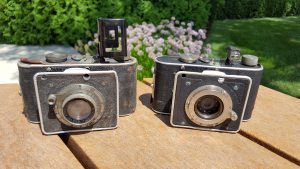
Cameras with cloth focal plane shutters are a funny thing. While they were designed to be light weight and flexible for the high speeds needed to obtain shutter speeds as fast as 1/500 second, the engineers that designed them likely never considered that over half a century later, there would be guys like me trying to still use them. But then these cameras were built with such a high level of quality that other than dust and debris, many of them are still capable of working as good as the day they were made.
It’s this conflict that causes you to take pause when entertaining the idea of trying to shoot with a very old camera with a cloth focal plane shutter like the Foth Derby, as many of them will have shutter issues, but otherwise are in good working order. It can be incredibly difficult to find a Foth with an operating shutter because of this reason. Another desirable 1930s German camera with a cloth focal plane shutter known to almost never work is the Kochmann Reflex-Korelle which I talked about in my recent “Cameras of the Dead” article.
Unlike the Reflex-Korelle however, the Foth Derby is a relatively simple camera with far fewer parts inside. There are no moving mirrors controlled by a piano string, the shutter is physically smaller, and there are no interchangeable lenses. So, if somehow I could find a Foth with a working shutter, I should be OK.
As fate would have it, I located one for sale that looked to be in nice physical shape and the seller stated that the fast speeds worked OK. The problem? The camera had no lens. The Foth Derby is not an interchangeable lens camera, so the only explanation that the lens would be missing is that someone took it apart.
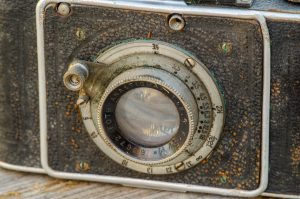
A second search for another Foth Derby turned up one in pretty terrible looking condition, and a dead shutter, but it had the optional f/2.5 Foth Anastigmat lens. The image to the left shows the f/2.5 lens in the condition I received it. It was covered with dirt, grime, and that bluish corrosion that you see when brass starts to oxidize. The glass elements had this milky white haze to it and were nearly completely opaque. The price was cheap enough though, so I took a chance on it hoping that I should be able to clean the lens good enough and swap it into the other Foth.
In my research of the Foth, I never found anyone who had attempted to swap lenses from one to another. I knew there were many different variants of the Foth Derby and even the two I had were of different eras, so I really had no way of knowing for sure if a swap was possible and even if it was, would the lens focus correctly. I guess there’s only one way to find out!
The first step in my research for this repair was to see if anyone had posted instructions online for taking apart a Foth Derby. Turns out, Nicholas Middleton had already done so and posted some excellent images on his Photo Analogue site. Seeing how simple his repair was, I was optimistic I could disassemble both cameras and take what was good from each and make one working camera.
I am not going to take the time to retype all of Nicholas’ instructions, but I’ll just post a collection of photos during this swap to show you the whole process. The Foth Derby is a pretty simple camera and the repairs are quite straightforward. The only tool you need is a precision flat head screw driver, some cleaning solution, and a whole lot of Q-tips. For cleaning the lens helical, I used a small glass Pyrex dish which allowed me to submerge it into naphtha oil. As usual, go slow, and take lots of pictures with a smartphone or digital camera so you can retrace your own steps during reassembly.
After putting the camera back together, I went through several cycles of the shutter to make sure everything was working properly. I also went through the extra step of checking focus accuracy by collimating the lens. I typed up instructions in my article for Breathing New Life Into Old Cameras where I show how it’s done on an Argus C3. I use the same exact process when collimating the lenses on any camera. It doesn’t matter if its a C3, Foth Derby, or folding camera, the process is exactly the same.
It’s a good thing I decided to check the focus, because to my dismay, it was off, WAY off. Thinking that perhaps I had reassembled the lens wrong and flipped a lens element or something, I put the camera on the shelf for a later time in which I would have the time to take a second look.
When I finally got around to looking at the camera again, I could see that the lens was assembled correctly. The 4 lens elements can only go in one way. If you tried to flip one, they either wouldn’t fit, or they would make contact with each other, so I knew that the order was not the issue. Knowing that infinity focus was off by quite a bit, I tried to move the bellows into a position to where I could get infinity focus accurate and I found that by pushing the bellows in part of the way, I could get infinity correct. This suggested that the f/2.5 lens achieved focus at infinity in a different position than whatever lens originally came in this camera (probably the f/3.5 Foth Anastigmat).
I still had the donor Foth that the f/2.5 lens originally came from, so I compared it and I could clearly see that when fully extended, the one that the f/2.5 lens came from did not extend out as far as this one was. At first, I thought I might need to swap the entire front lens standard and bellows from the parts camera to the good one, but that would have involved detaching the bellows, standard, and struts. There had to be a simpler way.
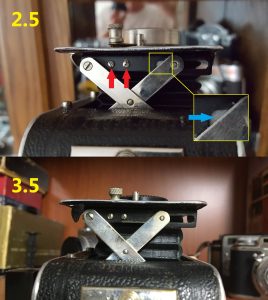 As it turns out, there was. The Foth Derby actually has an adjustment that allows you to fine tune how far the front lens standard extends at its fully erect position. If you look at the side of the lens standard, next to the struts, you’ll see 2 screws on each side. In the image to the right, these two screws are indicated by red arrows. Each of these 2 pairs of screws connect to a “stop” that is behind the bellows behind the standard. In the inset image of the 2.5 camera, you can see the stop indicated by a blue arrow. It is much easier to see with the lens and bellows removed. Detaching the bellows from the front standard is easily done by removing the 4 screws on the front plate of the camera.
As it turns out, there was. The Foth Derby actually has an adjustment that allows you to fine tune how far the front lens standard extends at its fully erect position. If you look at the side of the lens standard, next to the struts, you’ll see 2 screws on each side. In the image to the right, these two screws are indicated by red arrows. Each of these 2 pairs of screws connect to a “stop” that is behind the bellows behind the standard. In the inset image of the 2.5 camera, you can see the stop indicated by a blue arrow. It is much easier to see with the lens and bellows removed. Detaching the bellows from the front standard is easily done by removing the 4 screws on the front plate of the camera.
If you compare the two Foths in the image to the right, the bottom one has a Foth 3.5 lens, and the front standard sticks out farther. This causes the “stop” to be completely hidden inside of the camera. It’s subtle, but if you look close enough, you should be able to see the difference. Also note that the bellows are stretched farther on the 3.5 camera.
With the bellows detached, I was able to match this stop on the “good” camera with how it looked on the “parts” camera. This took quite a bit of time as I had to do it several times by trial and error, checking focus after each time until I got it right, but I eventually did.
I doubt there’s many people in the world who would take on a project like this trying to swap lenses from one Foth Derby to another, but if by some chance, another person finds this article and attempts what I did, know that the position of the front lens standard is not the same between cameras with the f/2.5 and f/3.5 Foth Anastigmat lenses.
My Thoughts
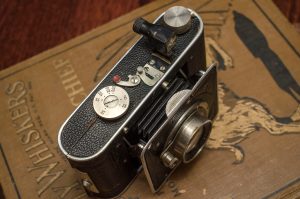
The Foth Derby represented a slight upgrade to the typical “Vest Pocket” folding cameras that were common in the early part of the 20th century. Featuring a focal plane shutter capable of speeds as high as 1/500 and quality German optics, the Derby’s target customer was likely someone who cared about getting good images from a camera, yet still valued a very compact offering.
The first time you pick up a Derby, the elegant and compact design of the camera immediately impresses upon you that this is no ordinary cheap camera. Despite it’s small size, the Foth Derby exudes quality. The body covering is genuine leather and not a leatherette or Vulcanite covering like those found on other inexpensive cameras.
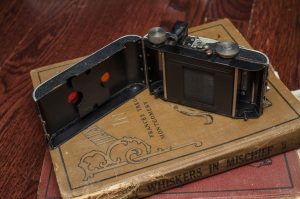
For it’s time, the Foth Derby was a pretty advanced camera. It was the smallest camera available with a focal plane shutter and helical focusing. All but the earliest Derbys have a self timer as well making it a pretty competitive camera. Loading film into the camera is like any other 127 roll film camera. The supply side is on the right and the film travels from right to left to a takeup spool.
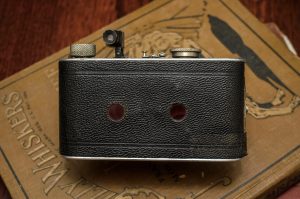
The Derby shoots “half frame” 4cm x 3cm images so that means you have to use both red windows on the back of the camera when advancing the film. How it’s done is that when advancing the film, the first frame is shot with the number one in the red window on the right. For the second frame, advance the film until the number 1 is in the red window on the left. For the third frame, the number 2 must be in the window to the right, and so on. You have to remember to use every frame number twice. The 16th and final image is shot with the number 8 in the left red window.
The camera has no double exposure prevention, which means you must advance your film and cock the shutter in two separate motions. There is no dedicated lever for cocking the shutter, instead you must manually turn the shutter speed selector until the shutter is in it’s “set” position.
The shutter speed selector works almost exactly the same as other German made cameras of the day such as the Leica rangefinder where you change shutter speeds by lifting the outer ring of the speed selector and rotate it around the inner part. You should set your shutter speed before cocking the shutter or else the speed markings will not line up.
Finally, in order to fire the shutter, you must press a button located on the front of the camera, in front of the shutter speed selector. The Derby is designed in a way where the camera must be extended before you can press the shutter release. This is a convenient feature as it prevents accidental exposure of an image with the camera collapsed.
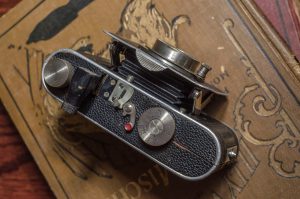
Using the Foth Derby is quite easy and simple to learn. The biggest issue using the camera today is finding one in good working order as every one I’ve ever seen has shutter issues. Fellow camera enthusiast Adam Paul reviewed his Foth Derby and had to make several concessions to get his to work. I had to go through two to get one that sorta works, and the few others I’ve seen in person all have varying degrees of issues.
It’s that last point that makes the Foth Derby such a challenge. My first attempt at shooting the camera came in September 2016 and involved a roll of custom 127 film cut down from a roll of 120 film. I cannot remember what emulsion it was, as I shot it nearly a year ago, but those images were plagued by a variety of issues. Many cloth focal plane shutters can develop pinholes over time, but the one in my Derby had threadbare strips where light came pouring through. It was much worse on the second curtain which suggested that any time the camera was cocked, even more light would come through. The camera also had another issue where the two curtains would separate, exposing the film, each time the camera was cocked. This proved to be fatal as that entire roll was basically ruined.
I scanned the images anyway and have them below for you to see. If you look real hard, you can see some promising detail to the images suggesting the Derby is capable of quality images, if it weren’t for the shutter.
I decided to shelve the camera and not post this review until I had another chance to shoot this camera. Since I knew the second curtain had many holes in it, I would make sure not to cock the camera until immediately before taking an image. And because the curtains would separate while cocking the camera, I would need to cover the lens each time I wound the camera.
It would take me over half a year to revisit the camera. I decided not to overthink my dilemma and took a square piece of heavy duty aluminum foil, and shaped it to the front of the lens and used that as a makeshift lens cap that I would leave on the camera up until immediately before capturing an image, and then I would cover it as soon as the photo was taken. Light would certainly still leak in, but I hoped that if I did this quick enough, the exposure of unwanted light would be minimized.
My Results
As long time readers of this site know, I always make every attempt to resurrect a camera for a review, but in the cases where the camera is too far gone to use, I will still give it a review in my “Cameras of the Dead” series. I firmly believe that every camera has a story to tell, and even if I can’t make any images with it, I can still teach the world a little about it’s history, how it works, and possibly even how the images might have looked.
The Foth Derby is a camera that I so desperately wanted to use and give a full review for. After my first roll in September 2016, I thought that if I was really careful, I could work around the camera’s shutter issues. As I mentioned above, this involved a home made lens cap out of tin foil that would remain over the lens at all times up until the exact moment I took a picture.
It was a bit of a pain as the foil would easily fall off, so I had to be extra careful when transporting the camera. I used a roll of expired AGFA Portrait film that was cut down to 127 size and loaded up the camera in the spring of 2017 and shot a second roll. I figured that if I could get at least some passable shots, it would be worthy of a full review, if not, then it would be featured in an upcoming Camera of the Dead article.
Before commenting on the images themselves, I have to explain that the AGFA Portrait film had deteriorated more than I had thought, and all of the images from the roll had these black specks and smudges all over them. These marks are from the film itself, and not a fault of the camera or the developing. The good news is that despite these issues, there’s still a lot to talk about with the images themselves.
I feel pretty confident in saying that my “workaround” mostly worked. A few light leaks still entered the camera in the form of red leaks from the back and white specks through the shutter curtain. I cropped many of these images eliminating the red light leaks near the edges, but you can still see it in some. The two shots in portrait orientation of the train and tracks both show white spots which are characteristic of pinholes in the shutter curtain. Despite my best efforts to block stray light from entering the lens, there’s still a delay of a second or so from when I’d need to remove my lens cap, take the image and recover it.
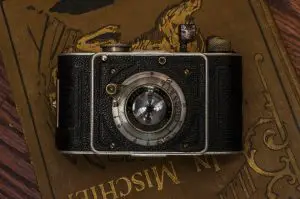
In terms of the image itself, the Foth Anastigmat f/2.5 lens is quite sharp. I can confirm this is a 4-element lens which renders scenes with even detail and minimal vignetting. It is uncoated though, so don’t expect really vibrant colors or flare resistance. If you are reading this review on a computer, I encourage you to open each image and view the full size 3000 pixel images. If you look past all of the anomalies, the underlying image is quite good. I can clearly say that during this camera’s hey day, with fresh film, it was capable of very nice shots. The 4cm x 3cm images are larger than those shot on a standard 35mm camera, so the images have a subtle medium format level of sharpness to them. I would feel safe to say that images shot on the Derby could safely be enlargened to 16×20 without any significant loss in detail.
I found the Foth Derby to have a unique combination of a compact and portable body, with very high build quality, great ergonomics, and a really sharp lens. It’s a real shame that so few are in good working condition, and the lack of easily available 127 film means that most Derbys are relegated to shelf queen duty. For as encouraged as I was to see the images from my second roll, I doubt I’ll use this camera much. I am really happy that I didn’t give up and stuck with it until I had a chance to see what it could do. If by some strange twist of fate, you ever come across one in good working condition, and are willing to locate some fresh 127 film, I absolutely encourage you to shoot it!
My Final WordHow these ratings work |
The Foth Derby was the smallest focal plane shutter in the world when it was first released. It was a well built and extremely compact camera with features inconsistent with it’s price. It has an aluminum body covered in real leather, a self timer, a top 1/500 second shutter speed, and can be equipped a very good 4-element f/2.5 Foth Anastigmat lens. The camera is extremely portable, easy to use, and looks great. It’s a shame that these are often found in operable condition, but when working, it is capable of excellent images that take advantage of the full 4cm x 3cm image size. It’s unlikely that many collectors will try to shoot with one, but if you happen to come across one that does work, I highly encourage you to give it a try! | ||||||
| Images | Handling | Features | Viewfinder | Feel & Beauty | History | Age | |
| 1 | 2 | 1 | 0 | 2 | 0 | 40% | |
| Bonus | none | ||||||
| Final Score | 8.4 | ||||||
Additional Resources
http://camera-wiki.org/wiki/Derby
http://quirkyguywithacamera.blogspot.com/2016/07/may-foth-be-with-you-derby-camera.html
https://mikeeckman.com/photovintage/vintagecameras/fothderby/index.html
http://www.earlyphotography.co.uk/site/entry_C209.html
http://photo-analogue.blogspot.com/2011/05/foth-derby.html
http://www.ukcamera.com/classic_cameras/foth1.htm
http://www.photoethnography.com/ClassicCameras/index-frameset.html?FothDerbyII.html~mainFrame

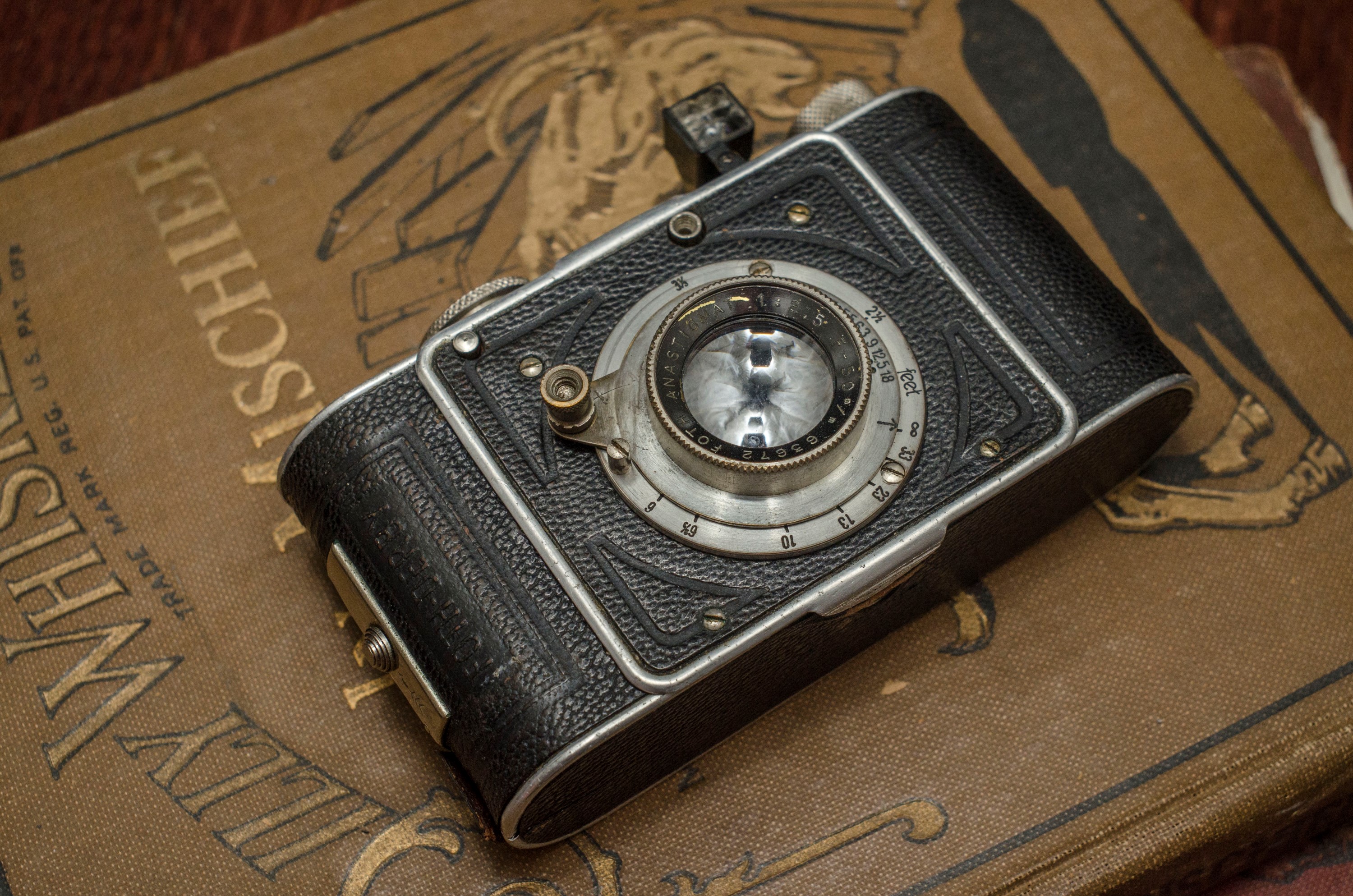
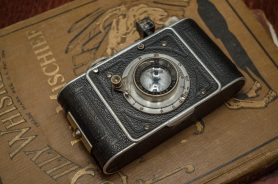
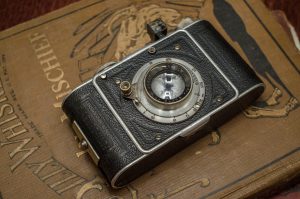
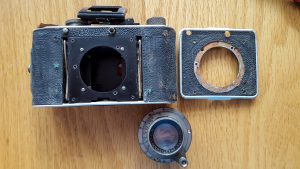

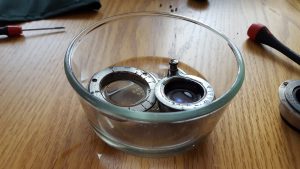

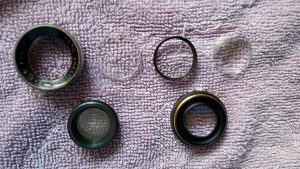


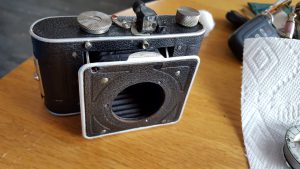

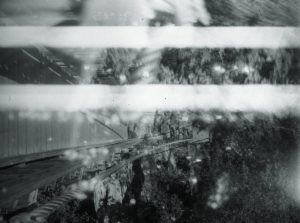

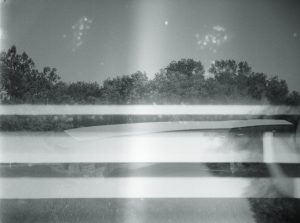
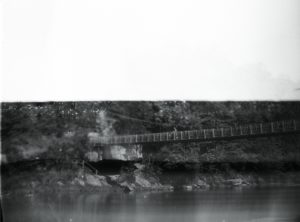
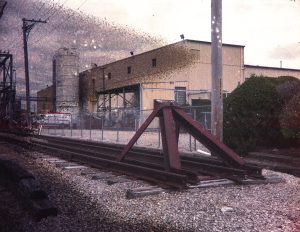
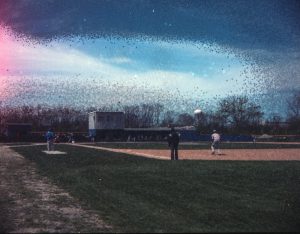

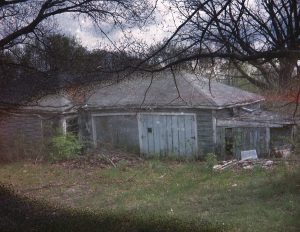

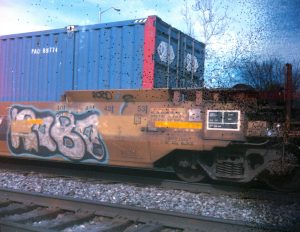
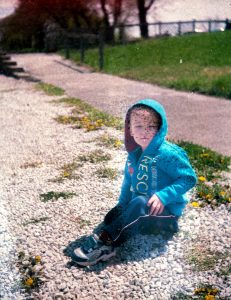
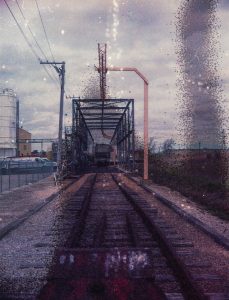

nice resourcefull article
Hi, I just made new shutter curtains for Foth Derby. That was not a hard job as camera is quite simple (and really well designed) . I also gave it full CLA as I needed to fully disassembly it. Now works perfectly and makes nice pictures.
I am very jealous. I would love to shoot a Foth Derby with new curtains and accurate speeds. Since writing this review, I’ve come across two others and none worked properly!
Does anyone know by any chance the measurements of the curtains and the little straps? I have replacement cloth at home but the original curtains are in such a deteriorated condition that I cannot fully reconstruct the measurements. Thanks in advance!
It’s been a while since you did this Mike; I just saw one of these on Shop Goodwill un-named with another camera bundle in case you want to go look. If you want the link let me know.